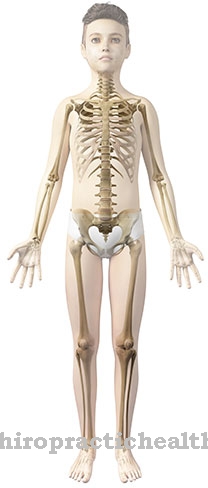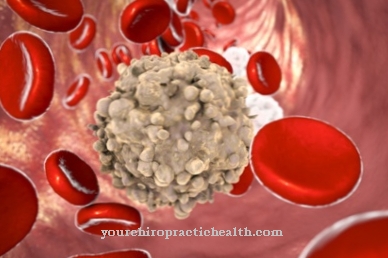migraine is a disease in which a severe headache is the focus of the suffering and the symptoms. Migraines are often accompanied by nausea, sensitivity to light and fear of noise.
What is a migraine?

The definition for migraine can best be described as a mostly one-sided headache with recurring seizures, which are accompanied by vomiting and nausea.
Those affected often perceive the migraine as a kind of painful aura that is characterized by neurological symptoms.
Above all, these include: turning black in front of the eyes, dizziness, paralysis, speech disorders, visual disorders and impaired olfactory and taste senses.
causes
The causes for migraine have not yet been fully explored. It is assumed, however, that familial or genetic reasons are behind this disease. Nerve excitability in particular plays a central role in this context. The thesis that insufficient blood supply to the brain (ischemia) is responsible for migraines is considered outdated. However, it is possible that e.g. a pinched facial nerve can cause a painful headache.
Today, however, it is believed that the neurotransmitter serotonin plays a major role in the development of migraines. Serotonin is a substance that functions to excite a nerve cell. Neurotransmitters have either an inhibiting or an irritating effect on the human sensation or nerve construct. In the case of migraines, the serotonin values are probably no longer in equilibrium, so that nerves or excitability are disturbed.
The distinctive headache is due to an excitation of the nerve fibers in the cerebral cortex. A painful, pulsating, or stabbing wave of pain can spread. Other causes can be lack of sleep, stress, bright lights, overload, smoking, alcohol and hormonal disorders.
Symptoms, ailments & signs
Migraines are very strong and persistent headaches that often only occur on one side. Typical symptoms of a migraine are headaches, photophobia or hypersensitivity to sounds. The well-known headache is the main symptom that every affected person suffers from.
The affected side on which the headache occurs is the same in many patients. The sharp pain builds up over two hours, so that in many cases it can even lead to attacks of nausea. The pain often has a restless and agonizing character, so that the ability to concentrate also decreases. Very simple activities such as climbing stairs can only be carried out with great difficulty and effort.
This also severely limits the general performance of the person concerned. Dry mouth at night is also a common symptom associated with migraines. A migraine has very clear symptoms, so that affected people can often make an explicit diagnosis themselves. Anyone who wants to achieve relief should definitely seek medical and medicinal treatment. Otherwise, there is a risk that the respective symptoms will intensify and worsen considerably.
Course of disease
The course of a migraine is structured in five phases:
- Preliminary phase: During the preliminary phase of a migraine, either hypersensitivity of the senses, ravenous hunger and hyperactivity occur or the entire opposite, i.e. fatigue, tiredness, nausea and sometimes constipation.
- Aura phase: As the name itself aptly describes, a kind of aura arises in the aura phase, which is mainly characterized by visual disturbances and other neuro-visual abnormalities.
- Headache phase: This is where the typical, boring, throbbing, pulsating or stabbing headaches occur. Nevertheless, the pain can occur in different places in those affected. In most patients, the headache is particularly pronounced on the forehead. This phase is accompanied by sensitivity to light, noise, nausea and sometimes vomiting. Some sufferers suffer so badly that they can only rest or lie motionless in darkened, quiet rooms. The duration of the headache phase is usually 4 to 70 hours.
- Recovery phase: In this phase of the migraine, the pain and symptoms decrease again. Those affected feel weak, tired and drained at the same time.
- Recovery phase: At the end of the migraine, the recovery phase begins, which takes up to two days. Only then will the migraine attack and headache completely disappear.
Complications
A migraine can be accompanied by various complications. One of the most feared long-term consequences is chronic migraines. Doctors speak of a chronic form if migraines occur for at least 15 days a month. The length of the pain does not matter. Increased seizures usually occur with a migraine without aura.
The so-called status migraenosus is also one of the migraine complications. With this form of migraine, the symptoms last longer than 72 hours despite medical treatment. In addition, there is frequent vomiting, which in turn creates the risk of dehydration (dehydration).
Sometimes the affected person's circulation even breaks down, so that inpatient therapy in a hospital is necessary. It often takes many years before status migraenosus occurs, with repeated migraine attacks and numerous medications being administered.
Another consequence is the migraine infarct, which is a cerebral infarction. It is accompanied by an aura that lasts for over an hour. One of the rare complications of migraines is the persistent aura. The aura symptoms last longer than a week.
However, a cerebral infarction cannot be proven. In most cases, the aura symptoms are bilateral. Permanent brain damage is not to be feared due to the persistent aura in contrast to the migraine infarct.
When should you go to the doctor?
If you have a recurring migraine, you should see a doctor for diagnosis. Therefore, every patient who has ever suffered from a migraine or who suspects that the migraine is behind recurring headaches should consult a doctor. First of all, the attending physician is concerned with reliably diagnosing the migraine and ruling out any other diseases that could cause such symptoms. Then a form of treatment has to be found that enables the patient to enjoy as much quality of life as possible despite the migraine.
If the migraine occurs in severe form or if the migraine attacks are so stressful that they lead to the inability to work, you should see your doctor again, because there are good treatment options nowadays.If the symptoms of a migraine change, get worse or even significantly better, the doctor should clarify why. The side effects of migraines also occur with other diseases. Migraineurs might overlook such symptoms or not take them seriously because they already know them from the migraines and attribute them to them. Changes in symptoms can also occur because the medication is no longer tolerated - the doctor may then need to change the dosage or the active ingredient.
Treatment & Therapy
The treatment or therapy of migraine usually takes years. Often a complete cure is not possible or not available. So far, medication and other therapeutic measures have mainly been used to treat migraines. This is mainly about relieving headaches and other symptoms or migraines.
On your own, you can reduce headaches mainly through cold compresses, migraine glasses, a lot of sleep, little stress, withdrawal from noise and bright light. Various foods should also be avoided. Foods that cause migraines can include alcohol, cheese, glutamate, and chocolate. Furthermore, therapeutic measures for coping with stress should be learned and applied. Autogenic training and progressive muscle relaxation have shown promise here.
Painkillers should only be taken in consultation with the attending physician. These include e.g. Antiemetic against nausea and analgesics (e.g. paracetamol, ibuprofen) against pain. Strong coffee can also help with mild headaches, as caffeine can be pain reliever.
Outlook & forecast
Migraines can take very different courses. Unfortunately, some people repeatedly have severe migraine attacks, others have irregular attacks that can be treated with medication. The prognosis depends on the intensity and cause of the migraines. Drug therapy using beta blockers, pain relievers or anticonvulsants such as topiramate is usually sufficient.
Severe migraine attacks represent an enormous burden in everyday life for those affected. Although the attacks decrease with age, the intensity can increase. The prognosis is rather negative, especially with an unhealthy lifestyle. Chronic migraine sufferers usually suffer from the symptoms for their entire life. The prognosis is better in children during puberty. The migraines usually subside after a few months without any long-term consequences. In affected women, the migraines often subside during menopause, in men during andropause.
However, ongoing therapy is usually required for migraines as symptoms can return after months or years. Life expectancy is not restricted by a migraine, but the quality of life is greatly reduced in migraine forms such as cluster headaches.
prevention
migraine is difficult to prevent. Nevertheless, a life without stress, lots of exercise or sport in nature or in the fresh air are among the most important preventive measures. A healthy diet with sufficient minerals and trace elements should also be ensured. Smoking and alcohol are taboo for migraineurs. Autogenic training can help prevent stress and thus also migraines for some sufferers.
Aftercare
The recurring pain attacks represent an enormous burden on the psyche and body. Headaches lead to over-blood flow in various areas of the body and are usually associated with high blood pressure and other complaints. Visual disturbances can lead to accidents and falls if the person suddenly has a migraine attack. In the long term, this can also lead to anxiety disorders.
Since emotional stress promotes the attacks, it is important for migraine sufferers to be particularly careful with their emotional balance. Excessive stressful situations should be avoided; instead, balancing sports such as jogging and yoga or swimming can help relax the mind and increase well-being.
Lots of fresh air and long walks should occur every now and then during the day to prevent mood swings, irritability and depressive moods. Many migraine sufferers suffer from hair loss or paleness, although these symptoms are caused by persistent stress. Sometimes aftercare should include psychological support.
You can do that yourself
Keeping a pain diary helps identify possible migraine triggers. If certain foods are responsible for the pain attacks, they must be consistently avoided. In many cases, migraine headaches that are dependent on the female cycle can be positively influenced by changing the method of contraception: for example, switching to a birth control pill without estrogen can bring about improvement.
Learning relaxation techniques such as yoga or Jacobson's muscle relaxation counteracts stress-related migraines, and regular sporting activities also reduce stress. Value should also be placed on a regular daily routine with sufficient breaks for relaxation.
In the early stages of a migraine attack, home remedies can stave off an attack or weaken it. Herbal preparations with willow bark, butterbur or rooibos have proven to be effective - this also ensures increased fluid intake, which should not only be observed during an acute attack. Alternating showers, treading water or cold arm baths can help as long as the pain has not yet fully started. Grated ginger is a powerful nausea remedy and, if taken in time, can prevent headaches in some cases.
If it is not possible to ward off the migraines in the early stages, the best way to survive an attack is in a quiet, darkened room. Painkillers available at pharmacies can provide relief, but a doctor should be consulted if migraines are repeated.

.jpg)











.jpg)

.jpg)
.jpg)











.jpg)